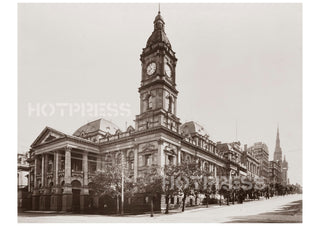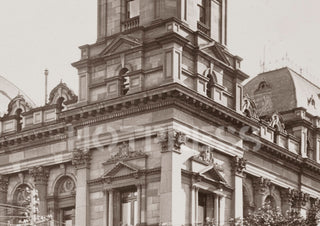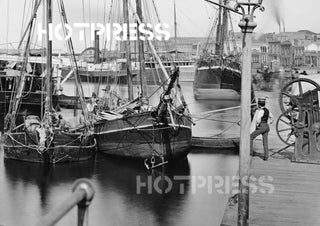1901 Melbourne Town Hall
Description
A beautiful photograph of the Melbourne Town Hall in 1901. The building occupies the north-east corner of Swanston and Collins Streets and was opened on 9 August 1870, originally without the front portico, which was added in 1887. The architect was Joseph Reed who also designed the State Library of Victoria (1854), The Royal Exhibition Buildings (1879), Melbourne Trades Hall (1873), Rippon Lea Estate (1868), Collins Street Baptist Church (1854) and many other wonderful structures in Melbourne and Geelong. The Melbourne Town Hall still stands today. Unfortunately, a fire in 1925 damaged a major part of the building. Because of the fire the mansard-style roof (as seen in this photo) was destroyed and was replaced by a simpler roof structure. The clock tower is actually called Prince Alfred's Tower, named after Prince Alfred, the Duke of Edinburgh, who officially laid the foundation stone in 1867.
This is a magnificent print that has had many hours of work being retouched, to present it as crisp and as clean as we can make it. Photograph attributed to Robert S. Brain, Government Printer.
All text © HotPress
Notes from the State Library tell us that this photograph is a "Souvenir of the visit of their Royal Highnesses the Duke and Duchess of Cornwall and York to Melbourne, Victoria, to open the first Parliament of the Commonwealth of Australia."
This is a digitally retouched reproduction of the original held by the State Library of Victoria. All prints are reproduced without the HOTPRESS watermarks.
Our team of conservators have worked on a high resolution digital image in order to remove blemishes and artifacts such as stains, mould, scratches and damage caused by the handling of the original. We strive to provide authentic representations of the original work that are suitable for enlargements that retain the tones and character of the original.
Description
A beautiful photograph of the Melbourne Town Hall in 1901. The building occupies the north-east corner of Swanston and Collins Streets and was opened on 9 August 1870, originally without the front portico, which was added in 1887. The architect was Joseph Reed who also designed the State Library of Victoria (1854), The Royal Exhibition Buildings (1879), Melbourne Trades Hall (1873), Rippon Lea Estate (1868), Collins Street Baptist Church (1854) and many other wonderful structures in Melbourne and Geelong. The Melbourne Town Hall still stands today. Unfortunately, a fire in 1925 damaged a major part of the building. Because of the fire the mansard-style roof (as seen in this photo) was destroyed and was replaced by a simpler roof structure. The clock tower is actually called Prince Alfred's Tower, named after Prince Alfred, the Duke of Edinburgh, who officially laid the foundation stone in 1867.
This is a magnificent print that has had many hours of work being retouched, to present it as crisp and as clean as we can make it. Photograph attributed to Robert S. Brain, Government Printer.
All text © HotPress
Notes from the State Library tell us that this photograph is a "Souvenir of the visit of their Royal Highnesses the Duke and Duchess of Cornwall and York to Melbourne, Victoria, to open the first Parliament of the Commonwealth of Australia."
This is a digitally retouched reproduction of the original held by the State Library of Victoria. All prints are reproduced without the HOTPRESS watermarks.
Our team of conservators have worked on a high resolution digital image in order to remove blemishes and artifacts such as stains, mould, scratches and damage caused by the handling of the original. We strive to provide authentic representations of the original work that are suitable for enlargements that retain the tones and character of the original.


